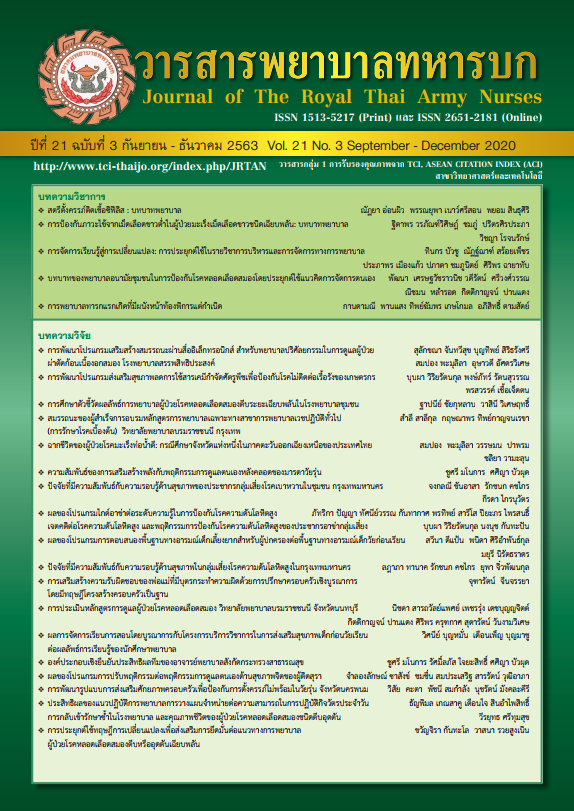Antecedents and Consequences Concerning Nursing Instructors’ Attitude and Behavior in Strengthening Zero Tolerance Practices in Nursing Students
Keywords:
role model, shaping, love and reason, attitude and behavior, zero tolerance practicesAbstract
The objectives of this study were 1) to explore the antecedents concerning nursing instructors’ attitude and behavior in strengthening zero tolerance practices in nursing students, 2) to analyze the paths of hypothetical and empirical model of the antecedents concerning nursing instructors’ attitude and behavior in strengthening zero tolerance practices in nursing students, and 3) to examine the canonical correlation between the behaviors in strengthening zero tolerance practices in nursing students and the nursing students’ attitude and behavior of zero tolerance practices. The samples were 104 nursing instructors and 104 nursing students. The instruments consisted of 7 scales for nursing instructors adapted from Keskomon et al.1 and 2 scales for nursing students written by the researchers following Fishbein and Ajzen2. Data were analyzed using frequency, percentage, arithmetic mean, standard deviation, Pearson’s product moment and canonical correlation coefficients, and path analysis.
The results were as follows: 1) the mean scores of all variables were quite high, 2) the hypothetical model of the antecedents concerning nursing instructors’ attitude and behavior in strengthening zero tolerance practices in nursing students was fitted with the empirical data ( (df = 10, n = 104) = 12.79, p = .24, NFI = .98, GFI = .97, AGFI = .90, CFI = 1.00, SRMR = .05, RMSEA = .053). 3) There was no statistically significant relationship between the behaviors in strengthening zero tolerance practices in nursing students and the nursing students’ attitude and behavior of zero tolerance practices at the level of .05 (r = .11; R2 = .01)
Downloads
References
Keskomon T, Sanee P, Neamsang Y. Antecedents and consequences concerning parental discipline practices in Thai police fathers. National Research Council of Thailand; 2007.
Fishbein M, Ajzen I. Belief, attitude, intention, and behavior: An introduction to theory and research. MA: Addison-Wesley; 1977.
Hoppe T, Anti-Corruption Expert. Checklists on corruption risks in the health care sector Bosnia and Herzegovina: Regional cooperation council; 2018.
Ministry of Public Health. Master plan for prevention and suppression of corruption and misconduct, Ministry of Public Health, 5 years (2017-2021) Nonthaburi: Anti-Corruption Operation Center; 2018.
Yorkovsky Y, Zysberg L. Personal, social, environmental, future orientation and attitudes mediate the associations between locus of control and pro-environmental behavior. Athens Journal of Social Sciences. 2020; 7: 1-18.
Akkarakittipong P, Kaewsutha N, Intarakamhang U. Psycho-social factors related cigarette smoking prevention behaviors of primary school students year 4-6 in Bangkok metropolitan. Veridian E-Journal, Silpakorn University Thai version. 2018; 11(2): 50-62.
Numniem S. Psychological and situational factors correlate of responsible behaviors of junior high school students (Master degree). National Institute of Development Administration; 2003.
Bhanthumnavin D. Antecedents of mindful risk-taking behavior in secondary school students: A path analytic approach. The Journal of Behavioral Science. 2015; 21(1): 75-94.
Thonglard P, Itakhan P, Budsaba B. The model of social responsibility behavior of Thai entrepreneur. Social Sciences Research and Academic Journal. 2015; 10(30): 49-66.
Praneetvatakul B, Bhanthumnavin D. Psychosocial correlates of communicable disease preventive behavior in public places for undergraduate students. Journal of Behavioral Science for Development. 2018; 10(1): 83-103.
Bhanthumnavin D. Documents for the action meeting (No. 1) subject “Research and development of Thai behavior systems: Research project to support national strategy” the national research council and the committee. of national institute for research and development of the Thai behavior system (28-31 October 2003); 2003.
Cohen J. Statistical power analysis for the behavioral sciences. (2nd ed.). Hillsdale, NJ Lawrence Erlbaum Associates, Publishers; 1988.
de Vellis RF. Scale development theory and applications. (2nd ed., Vol. 26). Thousand Oaks, CA Sage Publications; 2003.
Spector PE. Summated rating scale construction: An introduction. Newbury Park, CA Sage; 1992.
Lertsakornsiri M. The relationships between selected factors and nursing outcome in maternal-newborn and midwifery nursing practicum I at Saint Louis College. Journal of The Royal Thai Army Nurses. 2014;15(3): 321-330 (in Thai).
Downloads
Published
How to Cite
Issue
Section
License
บทความหรือข้อคิดเห็นใดใดที่ปรากฏในวารสารพยาบาลทหารบกเป็นวรรณกรรมของผู้เขียน ซึ่งบรรณาธิการหรือสมาคมพยาบาลทหารบก ไม่จำเป็นต้องเห็นด้วย
บทความที่ได้รับการตีพิมพ์เป็นลิขสิทธิ์ของวารสารพยาบาลทหารบก
The ideas and opinions expressed in the Journal of The Royal Thai Army Nurses are those of the authors and not necessarily those
of the editor or Royal Thai Army Nurses Association.






